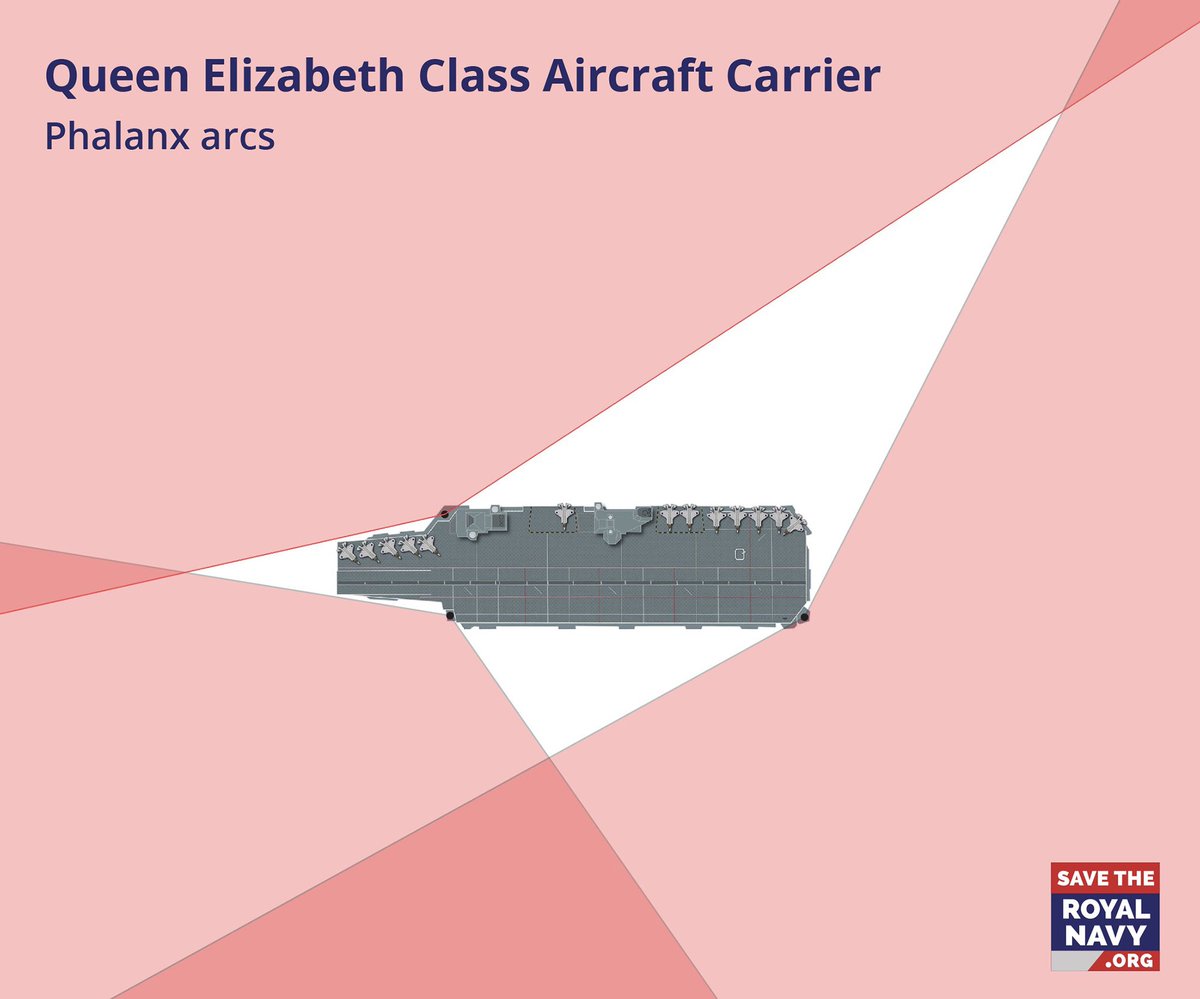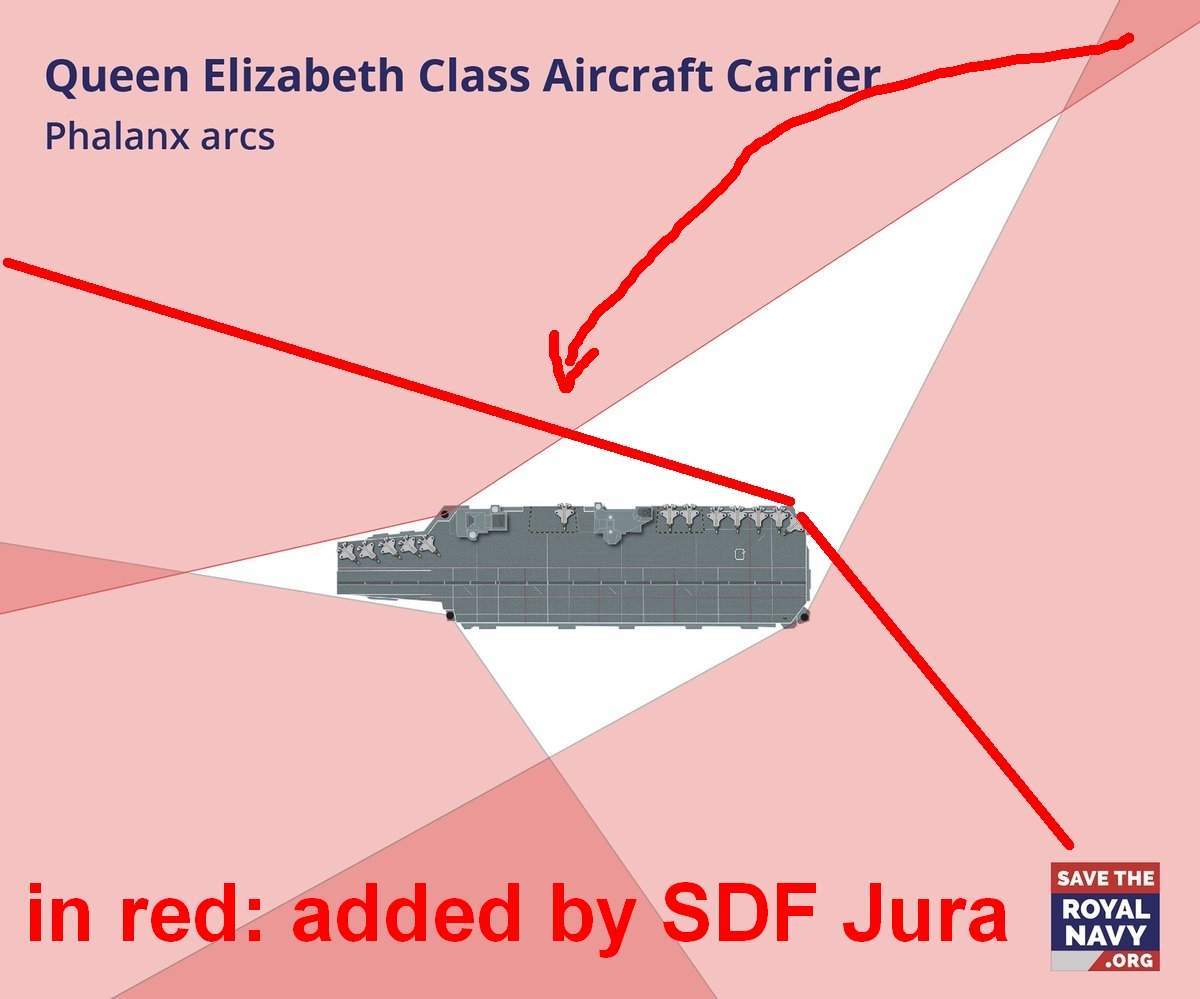You are using an out of date browser. It may not display this or other websites correctly.
You should upgrade or use an alternative browser.
You should upgrade or use an alternative browser.
Aircraft Carriers III
- Thread starter Jeff Head
- Start date
timepass
Brigadier
During Boeing's trip aboard the USS George H.W. Bush (CVN-77) supercarrier, some of our employees asked questions of the crew. Hear the exchange and see some great footage in this video . . .
timepass
Brigadier
Speaking of Hawkeyes, here’s a US Navy E-2C trapping aboard the French carrier Charles de Gaulle during cross-deck training ops.
timepass
Brigadier
A Hawkeye bagging a wire on the USS George HW Bush. Avengers!
timepass
Brigadier
Final checks before shooting a Bug off the end of the boat!
Thought the members here might enjoy this video:
Jura The idiot
General
noticed the tweet
Can the QEC aircraft carriers three Phalanx CIWS mounts provide 360º coverage of the ship? Simple diagram show the answer is yes.

^^^
yeah but:

Can the QEC aircraft carriers three Phalanx CIWS mounts provide 360º coverage of the ship? Simple diagram show the answer is yes.

^^^
yeah but:

Jura The idiot
General
whatever I still think, which is
Feb 27, 2018
Study looked at turning Izumo into a flattop to help U.S. in war
Feb 27, 2018
:yeah and I still think F-35 on the Izumos/Hyugas is FANBOISH BUNK
May 15, 2015
... I've read (in a Czech military journal) the width of the elevators on Japanese Helicopter Destroyers is 10.9 m, while the F-35B wingspan is 35 feet ... now I have to convert it35ft= 10.66800m ... a tight fit
Study looked at turning Izumo into a flattop to help U.S. in war
The Defense Ministry commissioned a study into the possible conversion of the Maritime Self-Defense Force's Izumo helicopter carrier into a full-fledged aircraft carrier in case Japan was required to provide rear-line support for a U.S.-led war.
The ministry in April 2017 asked Japan Marine United Corp., a Tokyo-based company that built the vessel, to look into ways to improve the capabilities of the Izumo.
Japan Marine United submitted its report to the Defense Ministry in March and the ministry released details, with some bits blacked out, on April 27.
The report states that the Defense Ministry's precondition for the study was to look into how the Izumo could be used to provide rear-line support to the U.S. military.
The company was asked to provide estimates for the cost and construction schedule if changes were made to allow U.S. F-35B stealth fighter jets to land vertically on the deck and to use elevators to transport aircraft to their hangars.
No mention was made in the study for having the SDF use the improved Izumo.
Some portions of the released report were redacted, including details on what changes would be needed to transform the Izumo into an aircraft carrier, as well as the costs to make the changes and the duration of the project.
The Defense Ministry had contended that it never considered converting the Izumo, and officials maintained that position even with the release of the study report.
One official said the study was conducted because, with the deployment of F-35B fighter jets to U.S. Marine Corps Air Station Iwakuni in Yamaguchi Prefecture, the need might arise to use the Izumo as a carrier during joint Japan-U.S. military training or when U.S. aircraft experienced mechanical problems.
However, one government source did not rule out the possibility of the Izumo eventually being converted into an aircraft carrier.
This viewpoint is in line with Prime Minister Shinzo Abe's policy that Japanese forces could be utilized to provide support to the U.S. military during situations where Japan's survival is threatened or situations that would harm this country's interests.
Jura The idiot
General
now noticed (dated April 25, 2018)
HASC Seapower Chairman’s Mark Pushes Two-CVN Buy, Study of Nimitz Extension
HASC Seapower Chairman’s Mark Pushes Two-CVN Buy, Study of Nimitz Extension
The markup of the National Defense Authorization bill by the chairman of the Seapower and Projection Forces subcommittee of the House Armed Services Committee advocates a two-carrier buy to save Navy funds and a study of another life extension of the USS Nimitz to enable the fleet to maintain a force level of 12 aircraft carriers.”
“The Secretary of the Navy may enter into one or more contracts, beginning with the fiscal year 2019 program year, for the procurement of one Ford-class aircraft carrier to be designated CVN–81,” the markup said. “The aircraft carrier authorized to be procured may be procured as an addition to the contract covering the Ford-class aircraft carrier designated CVN–80 that is authorized to be constructed under Section 121 of the John Warner National Defense Authorization Act for Fiscal Year 2007. … The Secretary of the Navy may use incremental funding to make payments under the contract.”
Navy leaders have encouraged a two-carrier buy as a way to reduce the carrier construction cost while building up the fleet faster to the 12-CVN part of the 355- ship requirement.
“With the delivery of the USS John F. Kennedy (CVN 79) in 2023, the Navy will reach their 12 aircraft carrier goal but will quickly lose this overall capacity with the programmed retirement of USS Nimitz (CVN 68) in fiscal year 2023,” the markup said. “The committee believes that there are several options to retain required aircraft carrier force structure to include accelerating construction of the Ford-class carriers. Additionally, the committee believes that service life extension options may be available for USS Nimitz. Therefore, the committee directs the Secretary of the Navy to provide a briefing to the House Committee on Armed Services by March 1, 2019, on options that exist to extend the service life of USS Nimitz, to include the extension of major components. Additionally, such a briefing should include cost estimates and major modernization components.”
The bill as marked up also would:
■ Require the Secretary of the Navy to procure the data rights to the new guided-missile frigate and recompete the frigate not later than the contract award of the 10th frigate.
■ Authorize the Secretary of the Navy to enter into one or more multiyear contracts for 625 Standard Missile-6 missiles beginning in fiscal 2019.
■ Authorize the Secretary of the Navy to enter into one or more multiyear contracts for up to 52 C-130J aircraft beginning in fiscal 2019.
■ Authorize the Secretary of the Navy to enter into one or more multiyear contracts for up to 24 E-2D Advanced Hawkeye aircraft beginning in fiscal 2019.
■ Authorize the Secretary of the Navy “to procure up to 10 foreign-constructed ships if the secretary certifies that the U.S. Navy has initiated an acquisition strategy for the construction of 10 new sealift vessels. Additionally, this section would limit 25 percent of the U.S. Navy Military Sealift Command's fiscal year 2019 expenditures until the Secretary of the Navy enters into a contract for the procurement of two used National Defense Reserve Fleet vessels and completes the capability development document for the common hull multimission platform.”
■ Limit the Maritime Administration from “procuring used training vessels for use as school ship replacement vessels,” noting that the Maritime Administration’s “short-term strategy would not support the long-term maritime academies' interests. The committee continues to support the new construction of these training vessels in the United States.”
■ Support development of the Advanced Low-Cost Munition Ordnance, a guided 57 mm projectile, to counter the growing threats posed by small boat swarms, unmanned aerial systems and other emerging threats.
■ Directs the Secretary of the Navy to provide to the HASC “an assessment of the current and foreseeable torpedo threats facing high-value units and the Navy's plan to adequately protect them, a description of the requirements for SSTD [surface ship torpedo defense], an assessment of the development program concerning each of the SSTD capability elements, the plan to consolidate responsibility of the SSTD program, and the plan to manage and sustain currently fielded SSTD systems.”
asif iqbal
Banned Idiot
noticed the tweet
Can the QEC aircraft carriers three Phalanx CIWS mounts provide 360º coverage of the ship? Simple diagram show the answer is yes.

^^^
yeah but:
Shocking money saving move there we have seen many of them
Why don’t they have overlapping fire on the island side which is most vunerable, elevators, engines and islands
Yet they decide to put on CIWS to cover the opposite side ?
If they really wanted only 3 then stick the aft CIWS on the other side to give dark red around islands better chance of knocking down anti ship missile hitting the island from blank side
